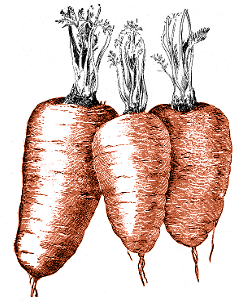Archive for the ‘The Old Garden In Bristol’ category
Posted in Planning, The Old Garden In Bristol on Sunday, September 25th 2011 (2.27 PM).
Before we start planning for next year, I thought I’d explain a little about the position of Symbolic Towers: the size of the garden, and the space we have to work with. So, I’ve drawn a little roughly-to-scale diagram. Stupidly, I forgot to put a north arrow on it: north is in the bottom-right corner.
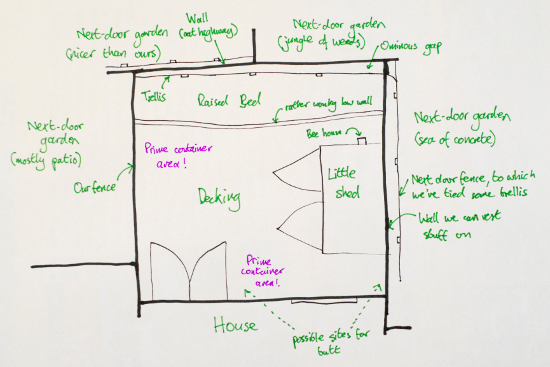
We are, according to aerial photos, roughly square, and facing south-west. Most of the garden is covered in decking; along the back, there is a raised bed formed by a wall, which is neither straight nor vertical. The bottom of the raised bed, incidentally, is largely sealed with cement, and the soil inside it is the usual urban garden mix of grit, broken crockery, broken glass, and lumps of coal.
Behind the raised bed is a wooden trellis, which starts off tight up to the back wall of the garden at one end, but is about 6 inches away from it at the other. This leaves an ominous gap which is largely used by invading cats. Our best plan for this gap is to fill it with rocks and logs, for the benefit of beetles and other wildlife. The back wall of the garden is fairly low, and is used by the said invading cats as an easy route through the neighbourhood.
The wall on the right-hand side of the garden – the north-west side, if you’re keeping track – is a similar height, about 4 feet, and is a good spot for pots and boxes where the shed isn’t in the way; although the shed itself, being a small one, is no higher than the wall. The neighbours on that side have put up a high wooden fence on concrete posts, a good few inches back from the line of the boundary; we’ve tied a willow lattice onto the back of their fenceposts, in the hope of improving the appearance a bit. On the opposite side, the fence is on our side of the boundary, and is a standard 6-foot wooden panel fence; we’ve stained it, and the shed, green.
What with the south-western aspect, and the high fences all around, there’s a variety of conditions. The wall of the house gets plenty of sun and heat; but the back left corner of the bed is almost always in shade, a thin skin of algae usually growing across the soil surface. The back right corner of the bed is brighter, but is always under threat from the overgrown mass that is the garden of the neighbours on that side: tendrils of bindweed and reaching branches of bramble always probing into our garden from that direction. Our prime growing sites are: the area on the left in front of the bed, which gets a lot more light than a couple of feet further back; and the area in front of the kitchen window, next to the back doors. We’re tempted to use up some of that space, though, for a water butt; most of the house’s water catchment drains into a downpipe by the kitchen door, and it would be criminal not to even try to consider saving some.
introduction, plan, sketch
Posted in Garden Diary, The Old Garden In Bristol on Sunday, September 18th 2011 (9.43 PM).
Since the last “week in the garden” post, we have:
- Done nothing, because we went away on another holiday.
And, the garden hasn’t enjoyed it at all, although I have no idea what the weather was doing. Some of the beans are healthy, but some are rather withered and shrivelled. The spring onions, lovely and healthy a couple of weeks ago, are now looking fairly unrecoverable. The bolt-free coriander seeds we carefully sourced have come into flower, which makes me think it was probably too hot and dry to leave a container garden to its own devices for a week. On the bright side, the Swiss chard is happily sprouting up again with some vigour, when we thought we had harvested all we could get from it.
Still, we always said: after the September holiday we would start planning next year’s garden; start getting ready for the winter and working out our planting. Next weekend we start hacking back the perennials and working out how long it is worth keeping the beans and so on in their planters for; and after that we sit down with pen, paper, charts and calendars, working out what to plant when. So, coming up soon: some posts on how our garden is arranged, situated, and what we think we can do with the space.
autumn, coriander, diary, disaster, green bean, holiday, runner bean, scallion, spring onion, swiss chard
Posted in Experimentation, Garden Diary, Photobloggery, The Old Garden In Bristol on Wednesday, September 7th 2011 (10.14 PM).
Since the last “week in the garden” post, we have:
- Harvested the first green beans.
And, because we went away for a long weekend, that was about it. The garden didn’t take too kindly to us going away, either. Or, rather, it didn’t take too kindly to the weather: the combination of dry, hot days without us there for watering, followed by heavy rain, has not had good results. The spring onions have suffered in particular, and the runner beans have also had problems.
Back in the mists of time – well, August – before this blog had properly started, we sowed a few boxes of quick-growing things to give us some more produce into the autumn. As I mentioned then, I tried an experiment. All of the seeds were sowed into previously-used compost; and for each seed, I sowed one box into compost that had been used to grow peas, and one box into compost that hadn’t. It’s three-and-a-half weeks later now, and the results are pretty clear, at least for the radishes.
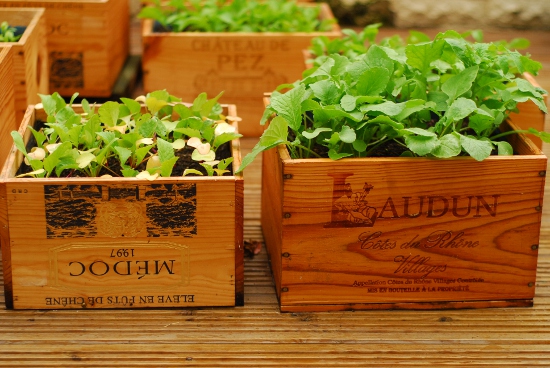
The pea compost is, I’m fairly sure, the one on the right. Science!
bean, compost, diary, experiment, french bean, green bean, nitrogen, pea, radish, scallion, science, spring onion, weather
Posted in Garden Diary, The Old Garden In Bristol on Tuesday, August 30th 2011 (7.10 PM).
This week, we have:
- Continued harvesting runner beans, and also the first of the green beans
- Harvested a box of radishes, leaving the two we planted a couple of weeks ago still developing.
- We’ve still not quite got the hang of radishes. We thinned out the still-growing boxes, rather more than previously, in the hope of getting a nice bulb on every plant.
- Harvested the last of the carrots.
- Harvested pretty much all of the mature Swiss chard – the baby leaves are still untouched
- Thinned out the smallest beetroot plants.
Before long, I suspect, we’ll have to look at chopping back some of our perennials for the winter. The camomile plant is definitely looking a bit too straggly and overgrown; the sage needs harvesting for its own health; and so, I suspect, do the chives, having taken a bit of a battering in the recent weather. We’re also not entirely sure when would be best to start harvesting our spring onions. They feel as if they’ve been in the ground an awfully long time, some of them, but their stems don’t seem to have reached a good width yet. Well, this always was intended to be a Learning Year.
bean, beetroot, camomile, carrot, chard, green bean, radish, runner bean, sage, scallion, spring onion, swiss chard, thinning
Posted in Photobloggery, Planning, The Old Garden In Bristol on Sunday, August 28th 2011 (9.44 PM).
When we moved into Symbolic Towers, back in the summer of 2010, we were both novice gardeners. We were moving from a flat with a tiny little spit of decking in front of the living room, generally overtaken by brambles, so one of the things on the house-buying shopping list was: a garden that wouldn’t overwhelm us. Something that would give us some outside space we could use, but nothing that would need too much work to look after. We found: a little square of garden, almost all decked over, with a strip of bedding and a newly-erected trellis along the back.
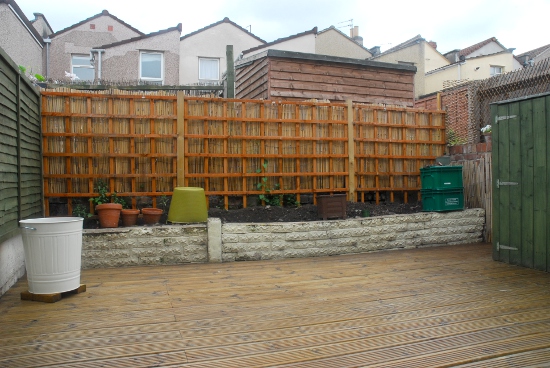
For the first 10 months after moving in, we did practically nothing to the garden, other than try to dig up the bindweed which quickly started poking itself up through the back bed. When spring came around, though, we decided it was time we started gardening. Time we started to make something of it.
Neither of us had ever designed a garden before, but we came up with a few basic principles.
- Our garden should be primarily an edible one; if we’re going to put all that work it, we wanted to get something to eat at the end of it.
- Above that, though, it should be organic and wildlife-friendly, up to the point that said wildlife start trying to eat the produce.
- “Wildlife” also does not extend to the cats from down the street who see the back bed and think “litter tray!”
- Pulling all that decking up would be far too much work. So our garden will be a container-based garden. Which does mean, for one thing, that if we decide we’ve planted things in the wrong places, we can move them all around later.
- We’d already discovered that the bed was full of bindweed rhizomes; digging those up, we discovered it was also full of broken glass and leylandii roots. So, for the first year, container gardening would be the thing, whilst we also dug up the bed completely, got rid of all the glass, bindweed, and lumps of coal, and put the soil back again.
That was back in April, nearly 5 months ago, and our embryo container garden has come a long way: potatoes, beans and various herbs all harvested, flowers bloomed and died, and our plans for next year’s season already starting to be formulated. I decided to start writing a blog about it for, well, several reasons. The main blog has been a bit moribund lately, and I thought having a well-defined topic might spur me into writing more. Moreover, I thought this blog could become something of a garden diary, helping us remember when we’d planted what, how long different plants had taken to develop, and compare things year-to-year. And, if nothing else, it can be a place for us to keep and discuss plans and ideas for future growth. It’s an extension of the original blog, and hopefully the name isn’t too confusing; our little patch of containers is very unlike a forest garden.
I’ll post again soon, with more introduction: a bit more about the situation and conditions we have to play with. For now, though, here’s a picture which, compared with the one above, shows how far we’ve managed to get in less than half a year.
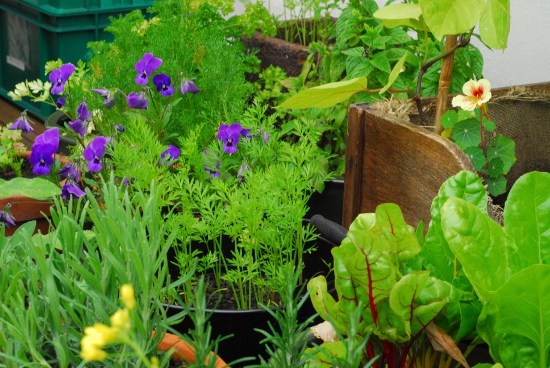
bindweed, blogging, introduction, overview
Posted in Garden Diary, The Old Garden In Bristol on Saturday, August 27th 2011 (10.27 PM).
Not very much has been happening in the garden in the past couple of weeks. Although everything is still productive, now the peas have gone it feels as if things have started winding down for the winter already. Having said that, the beans are still going strong; we’re picking a good handful of runner beans every few days, with plenty more blossom coming, and the first green beans are nearly ready to pick. The sweet peas planted under the green beans are going well, too, some of them almost as high as the beans themselves.
Maybe part of the winding-down feel comes from the weather: lots of rain, with some very heavy downpours, which have broken a few stems. It’s also delayed our ongoing project to dig out the back bed, which we really wanted to have finished by now.
back bed, bean, diary, digging, green bean, runner bean, sweet pea, weather
Posted in Photobloggery, The Old Garden In Bristol on Sunday, August 21st 2011 (5.15 PM).
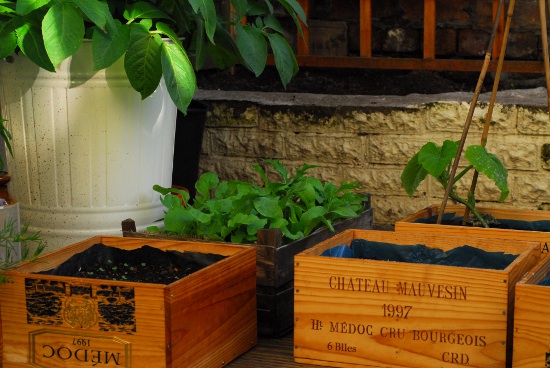
The back corner of the garden a couple of months back, when everything was still under the shadow of the potato leaves. Next year, the plan is for a rhubarb plant to take up the shade by the trellis.
containers, pattypan squash, plans, potato
Posted in Garden Diary, The Old Garden In Bristol on Wednesday, August 17th 2011 (6.12 PM).
On Saturday, as mentioned, we sowed a few boxes of quick-growing seeds to make them useful for what’s left of the summer. Radishes, rocket, and mixed salad leaves.
Today, four days later: all six of the boxes are sprouting already! I know radishes and rocket are quick germinators, but they weren’t this quick before.
germination, radish, rocket, salad leaves, sowing, sprouting
Posted in Garden Diary, The Old Garden In Bristol on Saturday, August 13th 2011 (6.59 PM).
This week we have:
- Pulled up the pea plants, post-harvest, and dug them in to the back bed
- Pulled up the English marigolds, and the rocket that had gone to seed
- Re-sowed the boxes this freed up: two with radishes, two with rocket, and two with mixed salad leaves
- Sowed the last of our Swiss chard seeds in a spare half-box.
In the name of Science, I sowed the new boxes in an experimental pattern. All of the boxes had the existing compost thoroughly turned over to dig in the roots that had been growing there before, then had extra compost added to top them up. For each of the three types of seeds, we sowed one box which had been growing peas, and one which had been growing something else. We’ll see if the nitrate-fixing effect of the pea roots is noticeable. My suspicion is: it won’t be, especially for fast-growing plants like the radishes, because the pea roots won’t rot down fast enough.
chard, diary, experiment, pea, radish, rocket, sowing, sowing plan, swiss chard

